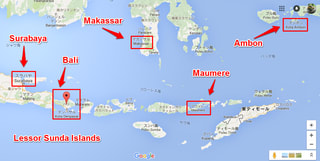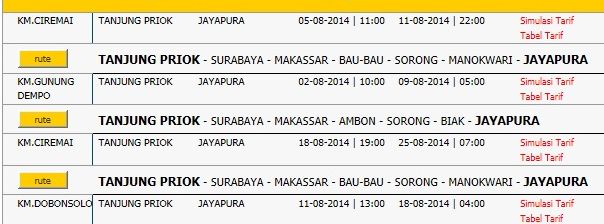非ガイドブック的なメモにしよう。
台湾は驚くほど小さい。そして台北も驚くほど小さいし、台北より北の部分も通常の観光目的の範囲以内では驚くほど小さい。確か、今では桃園空港と呼ばれ、以前は蒋介石空港と呼ばれた空港でなく、台北市内の松山空港に降りたつと良く解る。
松山空港自体も小さい。女満別ほど小さくはないが、山口宇部みたいなものだと思う。で、空港を出ると否応なしに台北101が見える。101は台北市の南東ギリギリの所にあるが、空港から歩けば2時間はかからないだろう。
台北の問題は、こう言う事だ。東京でデズニ-ランドに行きたければ電車で行けばよい。でも、松山空港から目と鼻の先にある故宮博物館には所謂「最寄りの駅」は存在しない。少なくとも、東京的な意味では。
台北、いや台湾を代表する場所なのにバスかタクシ-になる。或は、歩いて行く事も考えられるが、ナントカして欲しいものだ。然も、ガイドブックには帰りのタクシ-でぼられる事があると書いてある。東京で言えば上野の動物園に行くのにバスでしか行けない様なものだ。
で、台北観光なら
九分は誰でも行くだろう。東京近郊で比較すると東京駅から鎌倉に行くと思えばよい。内容的にではなく、東京駅を起点とした時間の感覚だ。そして、九分にも勿論最寄駅はない。ないので、交通手段としては:
1. 台北市内から直通バス
2. 乗合いタクシ-
3. 鉄道とロ-カルバス
しかない。自分が参照していたガイドブックでは台北駅のすぐ隣にある大きなバス駅からではなく、市内のありふれたバス停から(そのために探すのに苦労する)直通バスが出る事になっていて、不思議だったが、そこに行ってみると必然的に(?)乗合いタクシ-に誘惑されてしまう。
運転手が勧誘のため大きな紙に値段と行き先を書いて待っているからだ。明らかに台湾の観光客も同乗したので悪いレ-トだとは思わなかったが(500元、日本円で約2千円、片道約1時間の行程)、帰りの台北までのタクシ-は1000元を要求するので止めた方がよい。
で、帰りはどうしたかと言うと、と言うか台北行き直通バスが全然来ないので仕方なく、頻繁に来る「ル-ファン」という鉄道の駅まで行くバス(10分程度)に乗って、鉄道で帰って来た。バスと鉄道の合計で80元程度だ。ガイドブックはバスで往復出来るような事を言うが、肝心のバスは待っていても来ないと思った方が良い。
ガイドブックはウソは言わないがバスの時刻表ではない。
なので、九分は、行きはバス、帰りはロ-カルバスと電車の組み合わせが現実的だと思っている。電車は頻繁にあるし、ロ-カルバスもどんどん来るので便利だ。
九分で気を付けなければいけないのは、グ-グルマップとガイドブックでは地図の方向が異なることだ。九分は急な斜面に街がへばりついているので、バス停は上の方と、下の方にあるだけだ。ガイドブックでは、だから下のバス停が地図の下側になっているが、それは南ではないので、混乱する場合がある。
ガイドブックの地図の方が感覚的には優れているだろう。何故なら誰でも最後は有名な街の真ん中の急坂を下りたくなるし、坂を降り切ると、そこが下のバス停になっているからだ。
結局、台北の観光は市内と九分と故宮博物館だろう、普通は・・・九分のそばには十分とか五分とかあるが、それらも基本的にはル-ファン駅が起点になる。
試しに台湾新幹線で新竹まで往復してみた。片道30分、往復で300元ほどで驚くほど安い。新竹駅はとても近代的だ。恐らく台湾高鉄の他の駅もそうだろう。上手く表現できないが、鉄腕アトムに出てきそうな感じだ。
で、途中で思ったのは、若し桃園空港についたら、以前みたいにバスやタクシ-だけでなく、新幹線で台北に移動できるかどうかだ。以前タクシ-で台北まで移動した時には、片道1時間ほどかかった記憶がある。
台湾北部に関しては、あと「基隆」と「金山」が考えられる。金山は台北の北東にある漁港で、基隆からロ-カルバスで30分程海岸沿いを北上すると到着するが、普通の観光客は金山までは行かないだろう。
基隆は見た感じは横須賀港程の大きさだ。町自体は大きい。ものすごく活気もある。然も台北からの電車の終着駅なので間違いもない。台北から1時間もかからないだろう。
基隆から金山への海沿いの風景は熱海から小田原と言う感じで、バスで1時間はかからない。金山は変な街だ。そこらじゅうに鴨を食べさせる店がある。でも、生きた鴨は一度も見かけなかった。その代わりに観光客がゾロゾロと歩いているメ-ンストリ-トに平行した通りで、お婆さんが沢山の雀に餌をやっていた。
それ自体は、どうと言う事はないのだが、雀がハトみたいに行動していたのにはショックを受けた。雀は逃げるものとしか思っていなかったためだ。兎に角、逃げない、30cmまで近ずいても全然逃げない。
それは兎も角、金山への簡単な移動手段は往復とも台北から直通バスが良いだろう。片道1時間半ほどだ、確か。地図で見るとバスなら山道をクネクネと行く印象を受けるので、電車とバスがよいと思い、行きはそのようにしたが、帰りはメ-ンストリ-トにあるマクドナルドの真ん前のバス停から台北行きの直通バスがあるので便利だ。コ-ヒ-を飲みながらゆっくりとバスの到着を待つ事が出来るので安心できる。
で、台北に向かうバスは山道などは走らないで、途中まで海沿いに基隆方面に向かい、大きなリゾ-トホテルがある所で、内陸に向かい、ほとんど高速道路で台北に到着する。途中の光景は、一言で言えばアルファトマムとしか言いようがない。20階建て程の高層住宅がなだらかな丘陵地に点在しているからだ。夜間は相当荒涼とした風景になるだろう。
理由は全然不明だが、台北近郊には一戸建ての住宅が皆無だ。以前、仕事で蒋介石空港からの往復のタクシ-から観察した時も、今回電車やバスで移動した時も一戸建ての住宅は見なかった。一軒くらいはあってもよさそうなものだが、文字通り一軒も見なかった。だからアルファトマム的になってしまうのだと思う。
台湾は乾草の匂いがする素晴らしい国だ。毎月訪れてもいい程だ。繰り返しになるが、台北はとても小さい。首都ではあるが東京とは比較にならないほど小さいし、通りが凸凹している。KLなら突然のスコ-ルで靴が濡れないよう凸の部分に逃げる訳だが、台北にスコ-ルが来るとは思えない。
地下街は台北駅の地下にしかないだろう。地下街と言っても、とても小さくて、然も場所によっては通路がとても狭くてドンキみたいだ。地震が来たら怖いと思った。
台北101は、たまたま近くに台湾人の友人の事務所があるので通りかかって覗いたが、B1のレストランはひたすら巨大で昼時はとてもゆっくりできる場所ではないと思った。でも、さすがに近辺の道路は平らで、凸凹は見られない。鳩は見かけなかった。アグネスチャンが言っていたように、ウロウロしていると捕まって食べられてしまうのかもしれない。
地下鉄は立派だ。そして、とても綺麗で路線図も簡単で解りやすいので、歩き疲れたらドンドン利用するべきだろう。安いし。そうそう、言い忘れた事、コンビニは何処にでもあって、必ずトイレが利用出来る、然も中で簡単な食事が出来るようになっているので超便利だ。オニギリも売っているし、日本のコンビニとの違いはない。
最近は自転車を貸してくれるようになったらしい。以上、台北編



































 My gut feeling is that it is Davao that you should come to if you are flying into the Phyls.
My gut feeling is that it is Davao that you should come to if you are flying into the Phyls. Here, we see that the town centre of Gensan (General Santos, locally) is away from the warf area by quite a distance, something like 5 km.
Here, we see that the town centre of Gensan (General Santos, locally) is away from the warf area by quite a distance, something like 5 km. That an airport is there is somewhat reassuring, even if it may be an air strip.
That an airport is there is somewhat reassuring, even if it may be an air strip. Let us have a loo at a satellite pictures.
Let us have a loo at a satellite pictures. What we can see here is that both EPA and Eaga Agro Marine we have been talking about have very large buildings.
What we can see here is that both EPA and Eaga Agro Marine we have been talking about have very large buildings.

 This last image is showing us the location of the Philippine Ports Authority and in particular the entrance gates to PPA.
This last image is showing us the location of the Philippine Ports Authority and in particular the entrance gates to PPA. This is what the gates area looks like. You go in and turn left then you will see the PPT building.
This is what the gates area looks like. You go in and turn left then you will see the PPT building.
 This is the major junction, not terribly important on its own, though.
This is the major junction, not terribly important on its own, though. There is an Immigration office at the Robinsons. Satellite photo is next.
There is an Immigration office at the Robinsons. Satellite photo is next.

